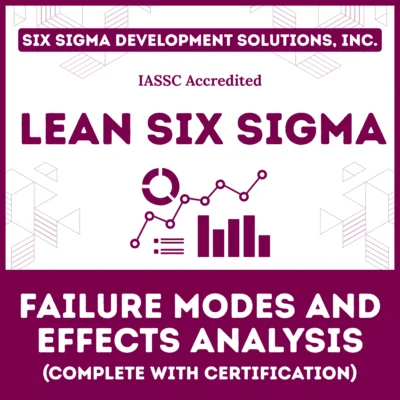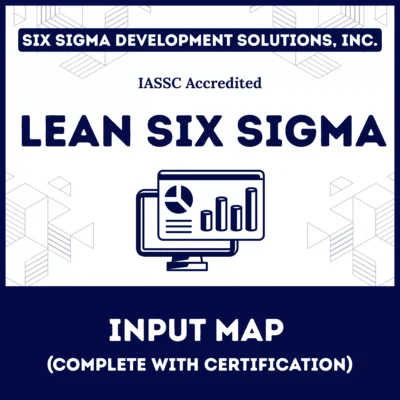Even experienced project managers encounter situations where their meticulously crafted plans spin out of control. Whether due to scope creep, resource misallocation, stakeholder misalignment, or unexpected risks, the outcome is the same—a project that is no longer on track.
This scenario is known as an out of control plan—a condition where your project has significantly deviated from its original scope, schedule, or budget, and corrective action is urgently needed.
An Out of Control Action Plan (OCAP) is a structured, predefined set of procedures and steps that an organization implements when a process deviates from its established “in-control” limits. These limits are typically determined using statistical process control (SPC) tools like control charts, which monitor process performance over time.
Think of it as a contingency map or an emergency response guide for a process. When a process goes “out of control” (meaning its output falls outside the acceptable range of variation), the OCAP provides a clear roadmap for teams to quickly:
- Identify the problem: Recognize that the process is no longer stable or predictable.
- Contain the issue: Take immediate actions to prevent further defects or negative impacts.
- Analyze the root cause: Investigate why the deviation occurred (e.g., equipment malfunction, operator error, raw material inconsistency, environmental changes).
- Implement corrective actions: Put in place solutions to address the identified root cause and bring the process back into control.
- Verify effectiveness: Monitor the process to ensure that the corrective actions have resolved the issue and the process remains stable.
Table of contents
- What Is an Out of Control Plan in Project Management?
- Key purposes and benefits of an OCAP
- Root Causes of a Plan Going Out of Control
- How to Bring an Out of Control Plan Back on Track?
- Tools to Support Project Recovery
- Case Study: Rescuing a Large-Scale Project
- How to Prevent Project Plans from Going Off Track (Out of Control)?
- Final Words
- Related Articles
What Is an Out of Control Plan in Project Management?
An out of control project plan is a situation where a project deviates so far from its intended trajectory that normal monitoring and control processes no longer suffice. This can manifest as:
- Constant missed deadlines
- Escalating costs
- Unclear deliverables
- Misaligned stakeholder expectations
- Declining team morale
When project governance fails and course correction is not immediate, it risks project failure—a costly outcome both financially and reputationally.
Public, Onsite, Virtual, and Online Six Sigma Certification Training!
- We are accredited by the IASSC.
- Live Public Training at 52 Sites.
- Live Virtual Training.
- Onsite Training (at your organization).
- Interactive Online (self-paced) training,
Key purposes and benefits of an OCAP
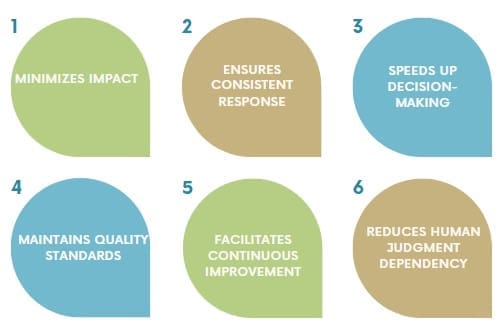
- Minimizes impact: By providing a quick and clear response, OCAPs help minimize the production of defective products, reduce waste, and limit downtime.
- Ensures consistent response: It provides a standardized approach for addressing out-of-control situations, ensuring that all team members respond consistently and correctly.
- Speeds up decision-making: Teams can act quickly and decisively without needing to convene meetings or seek extensive approvals.
- Maintains quality standards: It helps organizations uphold product quality and performance expectations.
- Facilitates continuous improvement: OCAPs are often part of quality management frameworks like Six Sigma (specifically in the “Control” phase of DMAIC), where they help sustain improvements and identify areas for ongoing refinement.
- Reduces human judgment dependency: By having predefined steps, it reduces the reliance on individual judgment during a crisis, lowering the likelihood of errors.
Early Warning Signs of an Out of Control Plan
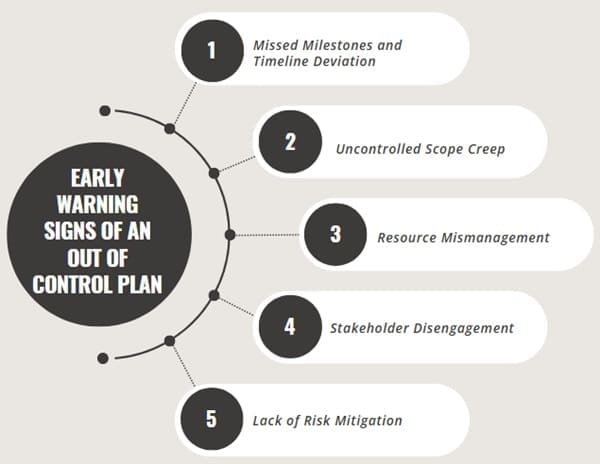
To regain control, you must first spot the signals. Here are the most common symptoms, tied with LSI keywords:
1. Missed Milestones and Timeline Deviation
Deadlines slip frequently, Gantt charts are out of date, and no one knows the real project status.
2. Uncontrolled Scope Creep
New features and requirements are added without formal change control, leading to a bloated workload and unclear priorities.
3. Resource Mismanagement
Team members are either overwhelmed or underutilized, and project budgeting doesn’t match real-time burn rate.
4. Stakeholder Disengagement
Stakeholders no longer attend meetings, provide feedback, or show interest—often due to poor stakeholder management and miscommunication.
5. Lack of Risk Mitigation
Risks identified during planning are either ignored or mishandled, causing avoidable disruptions.
Also Read: What is Advanced Product Quality Planning (APQP)?
Root Causes of a Plan Going Out of Control

Understanding the why behind a failing project is crucial for initiating corrective action. Key root causes include:
1. Poor Project Planning
Inadequate project scoping, fuzzy requirements, or unrealistic scheduling result in a fragile plan.
2. Ineffective Change Management
Without a structured change control process, the project scope is vulnerable to external influence, often leading to rework and resource strain.
3. Inadequate Communication
Project teams, executives, and clients must remain in sync. Lack of transparent communication can lead to project misalignment and distrust.
4. No Risk Management Framework
Ignoring risk registers or failing to review them regularly invites avoidable delays and budget overruns.
5. Lack of Project Governance
When decision-making authority is unclear or poorly executed, the project lacks a guiding hand to steer it back on course.
How to Bring an Out of Control Plan Back on Track?
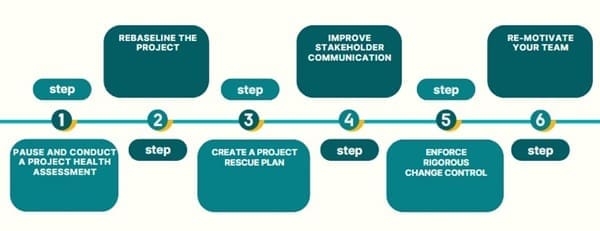
Once you’ve recognized your project is off course, you must implement a project recovery plan. Follow these proven steps:
1. Pause and Conduct a Project Health Assessment
Temporarily halt all activities and conduct a detailed project audit. Evaluate:
- Scope drift vs. original deliverables
- Current vs. planned resource allocation
- Actual cost vs. budgeted figures
- Quality of deliverables
2. Rebaseline the Project
Update your project schedule, cost baseline, and resource plan to reflect current realities. Ensure your baseline is approved by all relevant stakeholders.
Tip: Use earned value management (EVM) metrics like Cost Performance Index (CPI) and Schedule Performance Index (SPI) to justify rebaselining.
3. Create a Project Rescue Plan
Craft a targeted plan with:
- Clear scope realignment
- Realistic timelines
- Defined roles and responsibilities
- Immediate corrective actions
Use frameworks like Work Breakdown Structures (WBS) and Responsibility Assignment Matrices (RAM) to rebuild clarity.
4. Improve Stakeholder Communication
Schedule weekly progress updates and include visuals like Kanban boards or burn-down charts. Rebuild trust by sharing honest assessments and recovery goals.
5. Enforce Rigorous Change Control
From this point forward, any change—regardless of perceived size—must go through formal change request documentation and be evaluated based on project priorities.
6. Re-motivate Your Team
An out of control project often affects morale. Reset your team’s motivation through appreciation, transparency, and setting short-term, achievable goals.
Also Read: What is the Plan for Every Part?
Tools to Support Project Recovery
Here are tools that can assist in managing a failing or complex project:
| Tool | Function |
| Microsoft Project | Timeline, Gantt, and dependency management |
| Jira or Trello | Task tracking using Agile/Kanban principles |
| Asana | Team collaboration and goal alignment |
| Smartsheet | Budget, risk, and timeline management |
| Lucidchart or Miro | Visual collaboration and stakeholder mapping |
These tools help visualize progress, align teams, and manage workflows—critical elements in a project rescue scenario.
Case Study: Rescuing a Large-Scale Project
Industry: Construction
Problem: A government infrastructure project was 6 months behind schedule and 35% over budget. Stakeholder trust was eroding, and team productivity was falling.
Root Causes Identified:
- Lack of a formal risk management plan
- Frequent design scope changes without approvals
- Absence of a real-time progress tracking system
Corrective Actions Taken:
- Created a recovery schedule using Microsoft Project
- Assigned a dedicated change manager
- Instituted daily stand-up meetings for real-time updates
Results: The project regained stakeholder confidence, completed with only a 2-month delay, and stayed within the revised budget.
How to Prevent Project Plans from Going Off Track (Out of Control)?
Once you’ve recovered a failed project, implement these best practices to avoid future derailment:
1. Define Project Scope Clearly
Document detailed requirements and expected deliverables. Lock in the scope of work (SOW) and communicate it widely.
2. Use a Change Control Board (CCB)
Formalize a process where all changes go through structured review and approval, preventing unauthorized modifications.
3. Conduct Periodic Risk Assessments
Keep your risk register updated, assign ownership, and review it regularly during steering committee meetings.
4. Establish Project Governance Structures
Define roles, responsibilities, decision-making protocols, and escalation paths.
5. Train Teams in Project Management Methodologies
Encourage certification or training in Agile, Scrum, PRINCE2, or PMBOK frameworks to build consistency and expertise.
Final Words
Every project carries risk—but when your plan spins out of control, the worst thing you can do is ignore the signs. Whether it’s scope creep, missed milestones, poor communication, or weak stakeholder engagement, these symptoms often indicate deeper issues in your project structure and governance.
The good news? An out of control plan doesn’t have to lead to project failure. With the right recovery steps—like conducting a project health check, rebaselining timelines, realigning stakeholders, and strengthening change control—you can regain control and still deliver value.
Remember, even a failing project can be saved with proactive leadership, the right tools, and a commitment to transparent communication.
For project managers, the goal isn’t perfection—it’s resilience. By learning from setbacks and implementing preventive strategies, you build stronger, more adaptive teams ready for any challenge.












